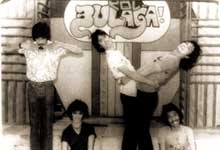
The noontime variety shows Eat Bulaga is one of the longest-running TV programs in the Philippines. Headlined by entertainers Tito, Vic, and Joey, it’s been on the air for 44 years this year and has become appointment TV for generations of Filipino viewers.
Produced by Television and Production Exponents (TAPE), Eat Bulaga has aired on GMA Network since 1995. It has survived numerous challenges over the decades but has never wavered in its commitment to deliver laughter and joy to its audience.
Here’s a look back at the history of Eat Bulaga.
History of Eat Bulaga
Eat Bulaga was first produced by a company called Production Specialists Inc., (PSI) which was owned by sportscaster Dick Ildefonso and businessman Romeo Jalosjos. Back then, PSI’s main business was producing the telecast of the games of the Philippine Basketball Association (PBA) in the late 1970s and early 80s. It was Ildefonso who hired Tony Tuviera at a time when the latter was jobless and was willing to work for a monthly salary of just P2,000.
The contract for the PBA was renewed annually, so PSI thought of developing a more stable and permanent TV program that would generate revenues. It was Jalosjos who suggested developing a noontime variety program that would compete with what was then the juggernaut that was Student Canteen. In an interview with the now-defunct Forbes Philippines in 2016, Tuviera remembered telling Jalosjos that producing a show that would go up against the ratings winner at the time “would be like banging our heads against a wall.”
Still, the fledgling company went ahead with the plan. The first order of business was to find a host that would serve as the anchor of the show. They managed to snag a trio of newcomers: siblings Vicente and Marvic Sotto, and Joey De Leon, collectively known as Tito, Vic and Joey. Tuviera says the three had actually turned down their offer “several times” as they said they were happy with their own early evening program, Discorama. The tripwould also make occasional appearances on the rival Student Canteen when the latter’s main hosts were away.
The original hosts of Eat Bulaga

Photo by Wikipedia.
But Tuviera says he finally wore the trio down. Eat Bulaga premiered on July 30, 1979 on RPN-9. Apart from TVJ, the original hosts included Chiqui Hollman, who served a foil to the wacky trio, and comedian Richie D’Horsey. As expected, the early years were rough. In Eat Bulaga: Ang Unang Tatlong Dekada, a coffee table book published to celebrate the program’s 30th anniversary, author and veteran entertainment journalist Butch Francisco, citing old records, said the show’s average rating for the first month was a dismal 5.2 percent versus Student Canteen’s 57.6 percent.
“The show’s advertising rates were reduced from the standard P2,000 to a really low P750 (payable after 30, 60, or even 90 days) or at an even lower P500 on PBB (pay before broadcast) terms,” Francisco writes. “Since Eat Bulaga was not generating revenues, it had to be subsidized by income from the PBA…but even then, the people still felt the pinch. The hosts were not paid their talent fees and the staff managed to get by only through cash advances.”
By December 1979, ratings had improved somewhat—20 percent for Eat Bulaga vs 44 percent for Student Canteen, but it was still not enough to dig the show out of an ever-deepening hole. Tuviera said their new venture was beginning to eat up the profits and the capitalization of PSI.
“It came to a point where we were garnished by the bank because we had a lot of debts at the time.” To be garnished meant the banks did not allow the company to access the accounts of PSI as these were used to pay off suppliers and other people the company owed. “So Mr. Jalosjos and I agreed. He said, ‘Get out. Form a company. If (Eat Bulaga) doesn’t rate in the next six to seven months, we’ll just close it down.’”
Winning the ratings war
But something happened just three months later. A new segment called “Mr. Macho,” a male beauty pageant developed to compete with a popular female version on the rival show, became a hit for Eat Bulaga. One day in October 1980, Eat Bulaga!’s ratings hit 31 percent while Student Canteen’s was at 29 percent.
“For the very first time,” according to Francisco, “Eat Bulaga! was able to topple Student Canteen in the race for noontime supremacy.”
That may have been a win, but the show wasn’t out of the red yet. By the time TAPE was incorporated in 1981, two years after Eat Bulaga started airing, the show was still bleeding money.
“We were still heavily in debt,” Tuviera told Forbes. “When TAPE started, we were about P8 million to P12 million down. We didn’t have receivables because it was garnished. Even if it was a new company, the banks still didn’t want to lend us any money, which is why, at the time, TVJ sometimes didn’t receive any salary. That went on for about for six months to a year. But TVJ never complained.”
Somehow the show survived. Tuviera says that by its 10th anniversary in 1989, Eat Bulaga was finally earning enough to be considered profitable. But, by that time, the show had made a move that sent shockwaves throughout the entire local broadcast industry: it moved from its home network of RPN Channel 9 (which had been sequestered by the government of then-President Corazon Aquino) to ABS-CBN Channel 2, whose ownership, in turn, had just recently been restored to the Lopez family after it was shuttered for 14 years during Martial Law.
As a television production blocktimer, TAPE’s business model is to buy airtime from the network, fill it with programming, and, in turn, sell commercial spots to advertisers. Tuviera explained that the amount for the airtime is fixed although there is an annual increase. The contract itself is good for three or six years. TAPE then does its own marketing when it resells to advertisers.
During year five of its six-year contract with ABS-CBN, the network announced a new policy: it would produce all of its programs in-house, which meant it would effectively reclaim its airtime and terminate its contracts with its blocktimers.
Tuviera said he was then forced to negotiate a deal with ABS-CBN’s rival GMA Network, which, according to the executive, was only too willing to offer them a deal. Eat Bulaga first aired on GMA on January 28, 1995, and it has been there ever since.
Overcoming challenges
The show has consistently stayed pretty much on top of the ratings game for all these years, but there have been several instances when its dominance was challenged by other upstarts. In 1987, for instance, just when rival noontime show Lunch Date was catching up in the ratings, precocious child star Aiza Seguerra, who was a contestant on Eat Bulaga’s Little Miss Philippines, stole the hearts of TV viewers and helped bring in more viewers. In the late 2000s, Willie Revillame’s Wowowee on ABS-CBN had been regularly trouncing its rivals when the comedian-host abruptly resigned, effectively putting a stop to his show and once again leaving Eat Bulaga! the sole, undisputed king of noontime television.
Eat Bulaga host Maine Mendoza on the cover of the print edition of Esquire Philippines, with co-hosts Wally Bayola, Jose Manalo, and Paolo Ballesteros

And then, of course, there’s It’s Showtime, the show carried by blockbuster entertainer Vice Ganda, which had begun to eat into Eat Bulaga’s ratings in the mid-2010s. But then the AlDub phenomenon happened—when the pairing of Alden Richards and Maine Mendoza—captured viewers’ attention and became a national obsession. A special episode of Eat Bulaga in October 2015 that featured a grand production centered around AlDub at the 55,000-seater Philippine Arena garnered an unprecedented 51 percent rating, the largest audience in local TV history, according to AGB Nielsen. Over 41 million tweets, meanwhile, were posted for the same event, leading Twitter to cite #AlDubEBSaTamangPanahon as the most used hashtag ever within a 24-hour period. Undoubtedly, the tandem helped turn a rapidly aging, predictable brand, fresh and relevant again.
Through the years, Eat Bulaga has helped thrust into the spotlight and launch into stardom other pop culture phenomenons, including Samantha Lopez aka Gracia, the Sex Bomb Dancers, the EB Babes, and child star Ryzza Mae Dizon, just to name a few.
Today the show has once again found itself at a crossroads. There have been reports of internal conflict after Jalosjos allegedly voiced out a desire to reorganize the show by kicking out mainstay hosts Tito, Vic, and Joey. Other networks, meanwhile, are waiting in the wings and have expressed willingness to welcome the trio should they find themselves out of the show that they’ve called their home for the last 44 years. There have been many reports on this front over the last few weeks and months, but as always with these things, we’ll just have to wait and see.
This is an edited version of a previous article the author wrote for a different publication in 2016.





